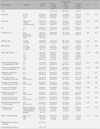Abstract
Purpose
This study was done to investigate the types of breastfeeding visits by mothers twenty-four months after birth and to identify the factors that increased breast feeding rates.
Methods
The subjects of this study totaled seven hundred and seventy-four mothers with infants aged 2 years or less who had visited national medical institutions including Sanhujori service facilities, breastfeeding care service facilities, and community health centers. Data was collected from June 22 to July 31, 2009. Data was analyzed using descriptive statistics, χ2 test, ANOVA with a post hoc Scheffe test, and multiple logistic regression.
Results
Major findings of this study were significant differences of planned length of breastfeeding and breastfeeding self-efficacy in relation to the differing types of breast feeding community visits by mothers. In multivariate logistic regression, baby's age, exclusive breastfeeding at hospital, utilization of breastfeeding care service facility, planned length of breastfeeding, and breastfeeding self-efficacy were independent predictors of the feeding type.
Conclusion
In order to increase breastfeeding rates, programs provided by public health care services and medical facilities should start education on breast feeding in the hospital before mothers are discharged and then continue through the use of Sanhujori service facilities and workplace at 3 month and 6 month postpartum.
Figures and Tables
Table 1
Descriptive Statistics of Mothers and Relation of Study Variables with Mother's Feeding Types (N=774)

References
1. Choi Y.J., Kim M.O. Effect of a breastfeeding management program on breastfeeding duration. Korean Journal of Women Health Nursing. 2007. 13(4):245–253.
2. Dennis C.L. Breastfeeding initiation and duration: A 1990-2000 literature review. Journal of Obstetric, Gynecologic, and Neonatal Nursing. 2002. 31(1):12–32.
3. Dennis C.L. The breastfeeding self-efficacy scale: Psychometric assessment of the short form. Journal of Obstetric,Gynecologic, and Neonatal Nursing. 2003. 32(6):734–744.
4. Dennis C.L., Faux S. Development and psychometric testing of the breasting self-efficacy scale. Research in Nursing & Health. 1999. 22(5):399–409.
5. Dunn S., Davis B., McCleary L., Edwards N., Gaboury I. The relationship between vulnerability factors and breastfeeding outcome. Journal of Obstetric, Gynecologic, and Neonatal Nursing. 2006. 35(1):87–97.
6. Faul F., Erdfelder E., Lang A.G., Bunchner A. G*power 3: A flexible statistical power analysis program for social, behavioral, and biochemical sciences. Behavior Research Methods. 2007. 39:175–191.
7. Forster D.A., McLachlan H.L. Breastfeeding initiation and birth setting practices: A review of the literature. Journal of Midwifery & Women's Health. 2007. 52(3):273–280.
8. Gartner L.M., Morton J., Lawrence R.A., Naylor A.J., O'Hare D., Schanler R.J., et al. American Academy of Pediatrics Section on Breastfeeding. Breastfeeding and the use of human milk. Pediatrics. 2005. 115(2):496–506.
9. Huggins K., Ziedrich L. The nursing mother's guide to weaning. 2007. Boston, MA: The Harvard Common Press.
10. Jang G.J., Kim S.H., Jeong K.S. Effect of postpartum breast-feeding support by nurse on the breast-feeding prevalence. Journal of Korean Academy of Nursing. 2008. 38(1):172–179.
11. Kim S.H. Factors explaining mothers' breastfeeding satisfaction. Korean Journal of Women Health Nursing. 2009. 15(4):270–279.
12. Kim S.H. Factors affecting mother's adaptation to breastfeeding. Journal of Korean Academy of Nursing. 2010. 40(2):225–235.
13. Kim Y. Effects of a breast-feeding empowerment program on exclusive breast-feeding. Journal of Korean Academy of Nursing. 2009. 39(2):279–287.
14. Kimbro R.T. On-the-job moms: Work and breastfeeding initiation and duration for a sample of low-income women. Maternal and Child Health Journal. 2006. 10(1):19–26.
15. Survey on the national fertility, family health and Welfare in 2003. Korea Institute for Health and Social Affairs. 2004. 03. Retrieved May 10, 2009. from http://www.kihasa.re.kr/html/jsp/public/public_01_01_view.jsp?bid=10&ano=163&contentType=1.
16. Survey on the national fertility, family health and Welfare in 2006. Korea Institute for Health and Social Affairs. 2006. 12. Retrieved May 10, 2009. from http://www.kihasa.re.kr/html/jsp/public/public_01_01_view.jsp?bid=12&ano=202.
17. Labbok M., Krasovec K. Toward consistency in breastfeeding definition. Studies in Family Planning. 1990. 21(4):226–230.
18. Lee S.B. A study on the nursing needs and service satisfaction of postpartal women in the postpartum care center. Inje Medical Journal. 2006. 27:77–86.
19. McCarter-Spaulding D.E., Dennis C.L. Psychometric testing of the breastfeeding self-efficacy scale-short form in a sample of black women in the United States. Research in Nursing & Health. 2010. 33(2):111–119.
20. Meedya S., Fahy K., Kable A. Factors that positively influence breastfeeding duration to 6 months: A literature review. Women and Birth. Women and Birth : Journal of the Australian College of Midwives. 2010. 23(4):135–145.
21. 2005 Korean national health and nutrition survey: Nutrition survey. Ministry of Health and Welfare. 2006. 07. 05. Retrieved October 12, 2007. from http://www.mw.go.kr/front/al/sal0301vw.jsp?PAR_MENU_ID=04&MENU_ID=0403.
22. Myers T. Mosby's dictionary of medicine, nursing, and health professions. 2008. 8th ed. St. Louis, Missouri: Elsevier Mosby.
23. Park E.Y. Breastfeeding knowledge, confidence, and intention to practice of postpartal women who used Sanhujori facility. 2009. Busan: Inje University;Unpublished master's thesis.
24. Pechlivani F., Vassilakou T., Sarafidou J., Zachou T., Anastasiou C.A., Sidossis L. Prevalence and determinants of exclusive breastfeeding during hospital stay inthe area of Athens, Greece. Acta Paediatrica. 2005. 94(7):928–934.
25. Research on the actual condition of breastfeeding. Planned Population Federation of Korea. 2005. 12. Retrieved May 15, 2009. from http://www.ppfk.or.kr/news/news_book.asp.
26. Riordan J., Wambach K. Breastfeeding and human lactation. 2009. 4th ed. Sudbury, MA: Jones and Bartlett Publishers.
27. Shiel W.C. Jr., Stöppler M.C. Webster's new world (TM) medical dictionary (3rd ed.). 2008. Retrieved June 20, 2010. Hoboken, New Jersey: Wiley Publishing;from http://www.medterms.com/script/main/art.asp?articlekey=38708.
28. Wang H.J., Kim I.O. Effect of rooming-in of new mothers on breast feeding rate. Korean Journal of Women Health Nursing. 2009. 15(1):5–12.
29. Yeo J.H. Influencing factors in breast feeding duration. Korean Journal of Women Health Nursing. 2005. 11(2):142–147.
30. Yoon J.W. The development and evaluation of the breastfeeding self-efficacy program for working mothers. 2005. Seoul: Korea University;Unpublished doctoral dissertation.




 PDF
PDF ePub
ePub Citation
Citation Print
Print




 XML Download
XML Download